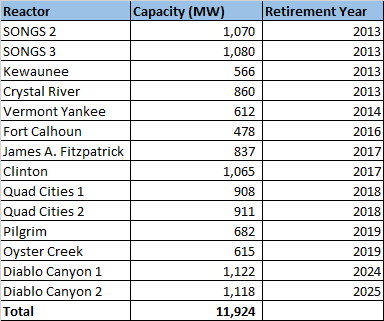Addressing the Plight of Existing Nuclear, Part 1
Introduction
Recent developments suggest the very real possibility that the U.S. risks losing its largest source of low-carbon electricity: existing nuclear power plants.
In the last two months, six nuclear reactors have announced that they plan to retire within the next nine years. They join five reactors that have already retired in the last four years as well as three reactors that plan to retire in the next four years. In total, almost 12 GW of nuclear reactors have either retired or plan to retire soon, representing ~12% of U.S. nuclear capacity at the beginning of 2011.

In many ways nuclear energy is the backbone of clean energy in the U.S. electricity system. In 2015, the nuclear fleet generated 20% of electricity in the United States, a level it has provided for decades. Today, despite the rapid and continuing growth of wind and solar, U.S. nuclear still constitutes more than half of carbon free electricity generation in the country.
From a climate change perspective, the closure of nuclear plants thus constitutes a major threat to U.S. carbon reduction goals under both the Clean Power Plan and the U.S.’s international commitment at the Paris climate accord. Many recent articles have highlighted this concern. Despite the potential climate ramifications, relatively little progress has been made on addressing the core economic challenges facing the nuclear fleet.
This article lays out the economic and technical challenges facing the existing nuclear fleet in both the short and the long term. It raises important questions about electricity market design as well as the feasibility of inflexible nuclear generation in a high renewable world.
One point deserves highlighting when discussing nuclear plants: the challenges facing existing nuclear power plants are very different from those facing new plants. In particular, cost and time overruns in the construction of new reactors are not a risk so much as they are a certainty. To construct a new nuclear unit is to bet that electricity policy, regulation, and markets will be able to support the facility through at least the 2060’s. Understandably, there are very few new builds in the U.S. and even these are found in increasingly less prominent rate-regulated markets. This article focuses only on the existing nuclear fleet and their challenges.
U.S. Nuclear Backbone of U.S. Clean Electricity
Commercial nuclear power has been around since the 1960’s, playing a key role in the nation’s electricity mix. Almost all of the nation’s 99 operating reactors were built decades ago. Although they originally suffered severe cost and time overruns, the capital expenditures for these plants have largely been paid off. Many of them are now approaching the end of their original 40-year licensing period and now require re-licensing if they are to continue operations for an additional 20 years.
Geography is critically important to understanding electricity in the United States; the situation is no different for the nuclear fleet. As most reactors began construction in the 1960’s and the 1970’s, they are concentrated in the eastern half of the country (reflecting population concentrations of the time).
Overall, nuclear power plants are some of the largest individual power plants in the country. The smallest nuclear reactor in the country is 478 MW, larger than most natural gas or coal units. Meanwhile, most nuclear reactors are 1,000 MW or larger.
While some nuclear power plants consist of only a single reactor, most nuclear power plants have two reactors while several have three. The largest nuclear power plant in the country (the massive three-reactor 4.2 GW Palo Verde Nuclear Generating Station) is the second largest power plant in the entire country. Singlehandedly, it generated almost 0.1% of the total U.S. electricity generation in 2011.
Nuclear reactors have exceptionally high capacity factors, usually exceeding 90%. U.S. reactors were originally built to meet baseload demand – when a reactor is running it is almost always generating at full capacity, with very limited ability to scale output up or down.
The only reason nuclear capacity factors are not 100% are outages: plants need to shut down every 18-24 months for maintenance and refueling, with plants also occasionally suffering forced outages due to various operating issues. Severe and lasting forced outages can greatly impact a plant’s revenue, meaning a lower than average nuclear capacity factor could indicate an economically struggling reactor.
These high capacity factors mean that despite only constituting ~10% of U.S. electricity generating capacity, the ~102 GW nuclear fleet generates ~800 TWh of nuclear generation every year, 20% of U.S. electricity needs. Over the last fifteen years, nuclear generation has been relatively flat, unlike most other power sources.
Existing Nuclear Plants Face Economic Headwinds
Fundamentally, existing nuclear power plants face two major challenges:
1. In the short term, electricity market design, low natural gas prices, and a lack of effective climate policy pose significant obstacles for large portions of the fleet.
2. In the long term, market impacts from high penetrations of renewables, increasing age of the U.S. nuclear fleet, and the need for an increasingly flexible system threaten the economics of almost all remaining nuclear reactors.
While these two challenges have considerable overlap, it is important to conceptually separate them as they have different implications for the future of U.S. energy and climate policy.
Market Design and Short Run Marginal Cost…



